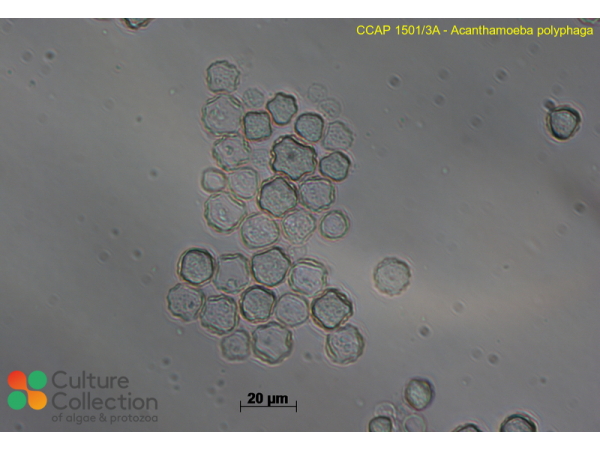References [ 10 ]
Costas M & Griffiths AJ (1984) The esterases and acid-phosphatases of Acanthamoeba (Amoebida, Acanthamoebidae). Protistologica 20(1): 33-41.
DOI: none
Daggett PM, Sawyer T & Nerad T (1982) Distribution and possible interrelationships of pathogenic and nonpathogenic Acanthamoeba from aquatic environments. Microbial Ecology 8(4): 371-386.
Nakisah MA, Fatimah H, Manaf AM & Aspollah MS (2008) Observation on the cytotoxicity of a plant compound labeled as MK2 on morphology of Acanthamoeba by Scanning Electron Microscopy. Annals of Microscopy 8: 73-76.
DOI: none
Nakisah MA, Faezah SS & Mohd TN (2014) Discovery of proteins in Acanthamoeba polyphaga with potential as biomarker for ammonium chloride contamination. Asian pacific Journal of Tropical Disease 4: 252.
Inglis TJ, Rigby P, Robertson TA, Dutton NS, Henderson M & Chang BJ (2000) Interaction between Burkholderia pseudomallei and Acanthamoeba species results in coiling phagocytosis, endamebic bacterial survival, and escape. Infection and Immunity 68: 1681-1686.
Marciano-Cabral F & Cabral G (2003) Acanthamoeba spp. as agents of disease in humans. Clinical Microbiological Reviews 16: 273-307.
De Jonckheere JF (1980) Growth characteristics, cytopathic effect in cell culture, and virulence in mice of 36 type strains belonging to 19 different Acanthamoeba spp. Applied and Environmental Microbiology 39: 681-685.
DOI: none
Hsueh TY & Gibson KE (2015) Transfer of Acanthamoeba spp. to fresh produce from water and environmental surfaces. Letters in Applied Microbiology 61: 192-198.
Fuerst, PA (2023) The status of molecular analyses of isolates of Acanthamoeba maintained by international culture collections. Microorganisms 11(2): 295.
Fuerst PA & Booton GC (2020) Species, sequence types and alleles: Dissecting genetic variation in Acanthamoeba Pathogens 9(7): 534.
Sequences [ 1 ]
EMBL/Genbank Links
(Bold text = submission by CCAP staff or collaborators)
Division/Phylum: Amoebozoa Class: Discosea
Note: for strains where we have DNA barcodes we can be reasonably confident of identity, however for those not yet sequenced we rely on morphology
and the original identification, usually made by the depositor. Although CCAP makes every effort to ensure the correct taxonomic identity of strains, we cannot guarantee
that a strain is correctly identified at the species, genus or class levels. On this basis users are responsible for confirming the identity of the strain(s) they receive
from us on arrival before starting experiments.
For strain taxonomy we generally use AlgaeBase for algae and
Adl et al. (2019) for protists.
| Attributes |
| Authority | (Puschkarew) Volkonsky 1931 |
| Isolator | Page (1964) |
| Collection Site | mill pond Madison, Wisconsin, USA |
| Notes |
Clonal culture; cystformer; isolated via plating |
| Axenicity Status |
Monoxenic |
| Area |
North America |
| Country |
USA |
| Environment |
Freshwater |
| GMO |
No |
| Group |
Protozoa |
| In Scope of Nagoya Protocol |
No |
| ABS Note |
Collected pre Nagoya Protocol. No known Nagoya Protocol restrictions for this strain. |
| Collection Date |
1964 |
| Original Designation |
23 |
| Pathogen |
Potential Pathogen: Hazard Class 2 |
| Strain Maintenance Sheet |
SM_Acanthamoeba.pdf |
| Toxin Producer |
Not Toxic / No Data |
| Type Culture |
No |
| Taxonomy WoRMS ID |
163677 |
| Equivalent Strains | ATCC 30871 |









